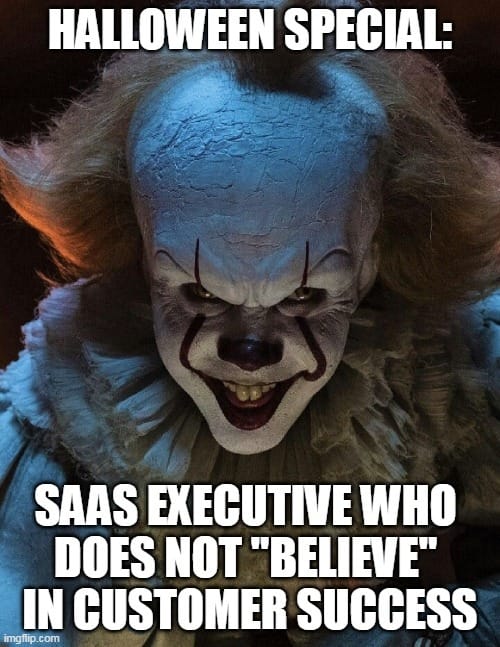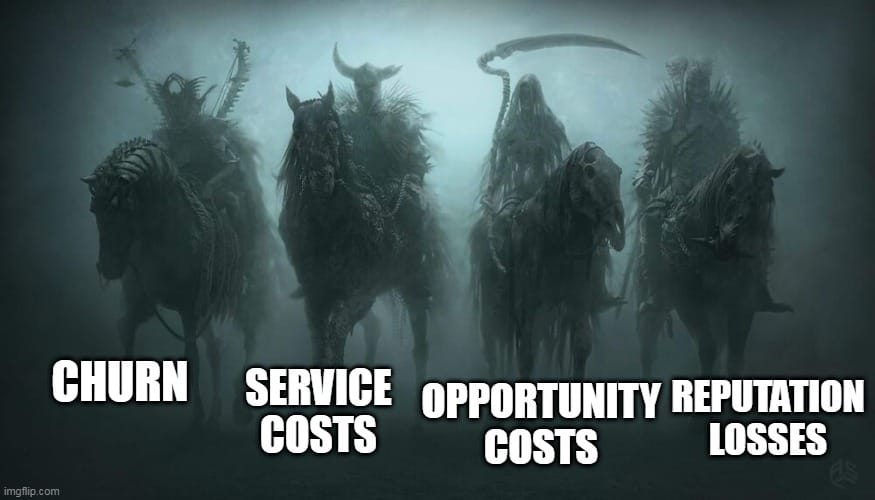
There are no hacks, magic bullets, and flying carpets in Customer Success.
Customer Success does not produce instant results. That’s not how it’s supposed to work even though there can be super fast effects.
Like customers signing up more users or buying more resources and features after a fast and successful onboarding.
But the main effect of Customer Success comes as compound interests
Customers sticking with you for a decade
buying more resources and features every year
driving an infinite amount of referrals
smoothly accepting price increases
buying future features and products
introducing your product when former customers join new employers
Customer Success easily accounts for 90% of all the revenue your company makes.
The reason is simple: The SaaS business model is literally built on Customer Success.
Recurring revenue is built on delivering recurring value.
It’s really frightening
What makes these executives so scary is that they don’t get it but have vast decision-making power.
Unsurprisingly, the scariest versions are occupying roles of the CEO, COO, or CRO.
They keep spending 90% of their budget on sales respectively new customer acquisition and care little about what happens afterward.
They think and act like the only requirement for customer renewals (and everything else) is to acquire them in the first place.
They have never abandoned the growth-at-all-costs approach, they are only doing it on a smaller scale.
Somehow you can’t even blame them because that’s what has been glorified in the SaaS industry for the past decade (at least).
It’s really hard to not fall for it and even harder to reverse that indoctrination.
However, as an individual contributor or leader in Customer Success, you only have 3 options to handle the situation
Accept it like it is and make the best out of it
Leave and look if the grass is greener somewhere else
Help those leaders to see clearly (again) and build a sustainable business
If you are choosing #3, you should continue reading.
The solution
The only way to cure them of their bias (we might even call it an addiction) is to continuously expose them to its negative impact they could or willingly did not see.

1. Churn
I’m sure this does not come as a surprise and most, if not all CS teams create churn reports in some way. That’s exactly the problem - some way might not be the right way.
It’s easy for the biased executive to deflect the issue and blame it on you. And it still happens over and over. It’s very likely that you are responsible for some churn. Despite your best efforts things are not always working out.
You need to go beyond presenting raw numbers and break churn down into
product design flaws
product performance issues
underwhelming customer support
misguided customer expectations
lack of customer-product fit
onboarding issues
failing to deliver on customer goals
and highlight #4 and #5. Pick a few examples and explain why these customers were doomed to failure right from the beginning.
What hurts the most when it comes to churn is when customers leave before the CAC is repaid. Losing future revenue sucks too but it’s no comparison to losing real money.
2. The Costs of Customer Service
Up to 50% of new customers log into the product only once before they disappear. 75% drop out within the first week. If the reason is that this is where they find out that the product is not the right choice you should consider yourself lucky.
Because your company “only” wasted acquisition costs. But what if they don’t find out themselves (that fast)? You are wasting a lot of resources on the road to an inevitable customer exit. Up to 10x as much compared to your top customers.
That makes the issue of non-repaid CAC even worse. Because customers that continuously consume a high level of support are not generating positive margins. That means every month they continue to stay, the debt grows.
Present a few examples of these customers and the numerous efforts you have taken to turn things around. Add an approximation of the costs (hours spent x hourly wage of CSM) to nail your point.
3. The Costs of Opportunity
You don’t have infinite resources. Neither in Sales, Product development nor Customer Success. For every activity you perform, you have to skip another one and do it later if possible.
A sales rep spending time running a demo for a bad-fit customer is not able to do the same for a customer fitting the ICP (without knowing) at the same time. By the time they get back to the latter one, they are already gone.
Now comes the juicy part. You have acquired the bad-fit customer triggering #1 and #2 leading to a significant loss. At the same time, you could have acquired a customer with high growth potential and profitability.
The same issue arises after the initial purchase. Customer Success Managers are all over the place to desperately “fix” the bad-fit customers. The time they spend on these futile attempts is missing from working with high-quality customers.
As a result, these customers won’t see the value it requires to create additional demand. Heck, it even puts their renewals in jeopardy. Quantify the losses based on highly profitable comparable customers.
4. Loss of reputation
Eventually, all your bad-fit customers will leave. The best thing you can hope for now is that they do it in pieces. But what if they blame you for their failure? What if they feel like they have been lured in under false premises?
They might feel like publicly sharing how they feel and leave negative reviews. Now it’s impossible to quantify the potential losses but that does not matter. Because there are rarely any executives that have this correlation even on the radar.
If possible, identify all the bad-fit customers leaving one of those negative reviews. Point out how this could have been easily avoidable.
There are no guarantees that it will work because some executives are simply immune to facts and common sense.
But with the right data, arguments, and resilience, you will be able to “reprogram” these executives in a positive way sooner or later.
And one thing is certain - you will definitely live happily ever after if you succeed.